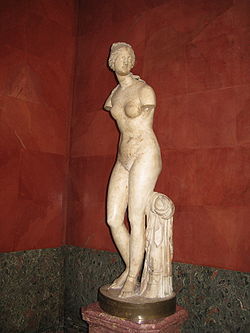
Aphrodite is an ancient Greek goddess associated with love, lust, beauty, pleasure, passion, procreation, and as her syncretized Roman goddess counterpart Venus, desire, sex, fertility, prosperity, and victory. Aphrodite's major symbols include seashells, myrtles, roses, doves, sparrows, and swans. The cult of Aphrodite was largely derived from that of the Phoenician goddess Astarte, a cognate of the East Semitic goddess Ishtar, whose cult was based on the Sumerian cult of Inanna. Aphrodite's main cult centers were Cythera, Cyprus, Corinth, and Athens. Her main festival was the Aphrodisia, which was celebrated annually in midsummer. In Laconia, Aphrodite was worshipped as a warrior goddess. She was also the patron goddess of prostitutes, an association which led early scholars to propose the concept of "sacred prostitution" in Greco-Roman culture, an idea which is now generally seen as erroneous.

Venus is a Roman goddess, whose functions encompass love, beauty, desire, sex, fertility, prosperity, and victory. In Roman mythology, she was the ancestor of the Roman people through her son, Aeneas, who survived the fall of Troy and fled to Italy. Julius Caesar claimed her as his ancestor. Venus was central to many religious festivals, and was revered in Roman religion under numerous cult titles.

The Venus de Milo or Aphrodite of Melos is an ancient Greek sculpture that was created during the Hellenistic period. It is one of the most famous works of ancient Greek sculpture, having been prominently displayed at the Louvre Museum since shortly after the statue was rediscovered on the island of Milos, Greece, in 1820.

The State Hermitage Museum is a museum of art and culture in Saint Petersburg, Russia. It was founded in 1764 when Empress Catherine the Great acquired a collection of paintings from the Berlin merchant Johann Ernst Gotzkowsky. The museum celebrates the anniversary of its founding each year on 7 December, Saint Catherine's Day. It has been open to the public since 1852. The Art Newspaper ranked the museum 10th in their list of the most visited art museums, with 2,812,913 visitors in 2022.
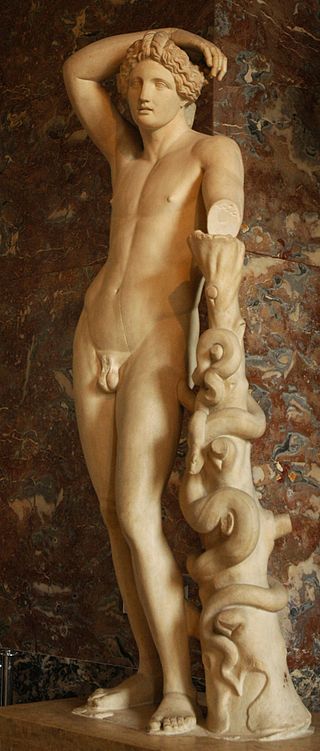
The Apollo Lyceus type, also known as Lycean Apollo, originating with Praxiteles and known from many full-size statue and figurine copies as well as from 1st century BCE Athenian coinage, is a statue type of Apollo showing the god resting on a support, his right forearm touching the top of his head and his hair fixed in braids on the top of a head in a haircut typical of childhood. It is called "Lycean" not after Lycia itself, but after its identification with a lost work described, though not attributed to a sculptor, by Lucian as being on show in the Lyceum, one of the gymnasia of Athens. According to Lucian, the god leaning on a support with his bow in his left hand and his right resting on his head is shown "as if resting after long effort." Its main exemplar is the Apollino in Florence or Apollo Medici, in the Uffizi, Florence.

The sculpture of ancient Greece is the main surviving type of fine ancient Greek art as, with the exception of painted ancient Greek pottery, almost no ancient Greek painting survives. Modern scholarship identifies three major stages in monumental sculpture in bronze and stone: the Archaic, Classical (480–323) and Hellenistic. At all periods there were great numbers of Greek terracotta figurines and small sculptures in metal and other materials.

The Aphrodite of Knidos was an Ancient Greek sculpture of the goddess Aphrodite created by Praxiteles of Athens around the 4th century BC. It was one of the first life-sized representations of the nude female form in Greek history, displaying an alternative idea to male heroic nudity. Praxiteles' Aphrodite was shown nude, reaching for a bath towel while covering her pubis, which, in turn leaves her breasts exposed. Up until this point, Greek sculpture had been dominated by male nude figures. The original Greek sculpture is no longer in existence; however, many Roman copies survive of this influential work of art. Variants of the Venus Pudica are the Venus de' Medici and the Capitoline Venus.

Venus Anadyomene is one of the iconic representations of the goddess Venus (Aphrodite), made famous in a much-admired painting by Apelles, now lost, but described in Pliny's Natural History, with the anecdote that the great Apelles employed Campaspe, a mistress of Alexander the Great, for his model. According to Athenaeus, the idea of Aphrodite rising from the sea was inspired by the courtesan Phryne, who, during the time of the festivals of the Eleusinia and Poseidonia, often swam nude in the sea. A scallop shell, often found in Venus Anadyomenes, is a symbol of the female vulva.

Tauride Palace is one of the largest and most historically important palaces in Saint Petersburg, Russia.

The Venus de' Medici or Medici Venus is a 1.53 m tall Hellenistic marble sculpture depicting the Greek goddess of love Aphrodite. It is a 1st-century BC marble copy, perhaps made in Athens, of a bronze original Greek sculpture, following the type of the Aphrodite of Knidos, which would have been made by a sculptor in the immediate Praxitelean tradition, perhaps at the end of the century. It has become one of the navigation points by which the progress of the Western classical tradition is traced, the references to it outline the changes of taste and the process of classical scholarship. It is housed in the Uffizi Gallery, Florence, Italy.

The Colonna Venus is a Roman marble copy of the lost Aphrodite of Cnidus sculpture by Praxiteles, conserved in the Museo Pio-Clementino as a part of the Vatican Museums' collections. It is now the best-known and perhaps most faithful Roman copy of Praxiteles's original.

The Capitoline Venus is a type of statue of Venus, specifically one of several Venus Pudica types, of which several examples exist. The type ultimately derives from the Aphrodite of Cnidus. The Capitoline Venus and her variants are recognisable from the position of the arms—standing after a bath, Venus begins to cover her breasts with her right hand, and her groin with her left hand.
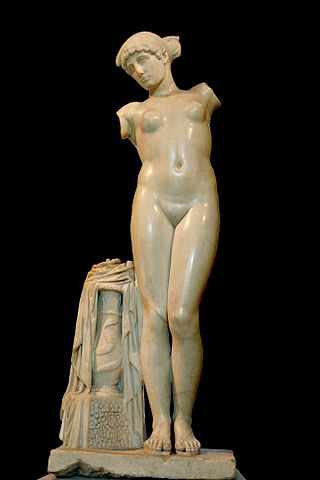
The Esquiline Venus, depicting the goddess Venus, is a smaller-than-life-size Roman nude marble sculpture of a female in sandals and a diadem headdress. It is widely viewed as a 1st-century AD Roman copy of a Greek original from the 1st century BC. It is also a possible depiction of the Ptolemaic ruler Cleopatra VII.

The Crouching Venus is a Hellenistic model of Venus surprised at her bath. Venus crouches with her right knee close to the ground, turns her head to the right and, in most versions, reaches her right arm over to her left shoulder to cover her breasts. To judge by the number of copies that have been excavated on Roman sites in Italy and France, this variant on Venus seems to have been popular.
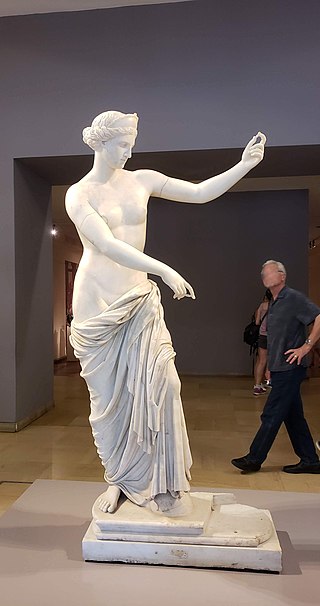
The Venus of Capua is a sculpture made during the empire of Hadrian. It is presumed that the Venuses of Milo and Capua are copies of an original lost Aphrodite, attributed to Lysippus, one of the great sculptors of classical Greece.

The Aphrodite of Menophantos is a Roman marble statue of the goddess Venus. Its design takes the form of "Venus Pudica", based on another statue, the Capitoline Venus. It was found at the Camaldolese monastery of San Gregorio al Celio in Rome, and is now in the Palazzo Massimo alle Terme, Rome. It bears the signature of Menophantos, a Greek sculptor, apparently of the 1st century BCE, of whom nothing more is known.
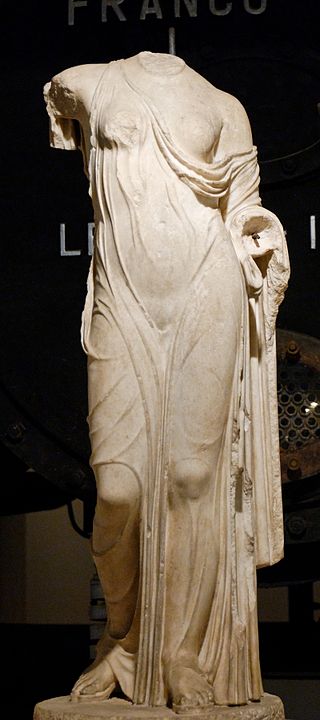
The Venus Genetrix is a sculptural type which shows the Roman goddess Venus in her aspect of Genetrix, as she was honoured by the Julio-Claudian dynasty of Rome, which claimed her as their ancestor. Contemporary references identify the sculptor as a Greek named Arcesilaus. The statue was set up in Julius Caesar's new forum, probably as the cult statue in the cella of his temple of Venus Genetrix. Through this historical chance, a Roman designation is applied to an iconological type of Aphrodite that originated among the Greeks.

The Venus of Arles is a 1.94-metre-high (6.4 ft) sculpture of Venus at the Musée du Louvre. It is in Hymettus marble and dates to the end of the 1st century BC.

The Venus Callipyge, also known as the Aphrodite Kallipygos or the Callipygian Venus, all literally meaning "Venus of the beautiful buttocks", is an Ancient Roman marble statue, thought to be a copy of an older Greek original. In an example of anasyrma, it depicts a partially draped woman, raising her light peplos to uncover her hips and buttocks, and looking back and down over her shoulder, perhaps to evaluate them. The subject is conventionally identified as Venus (Aphrodite), though it may equally be a portrait of a mortal woman.
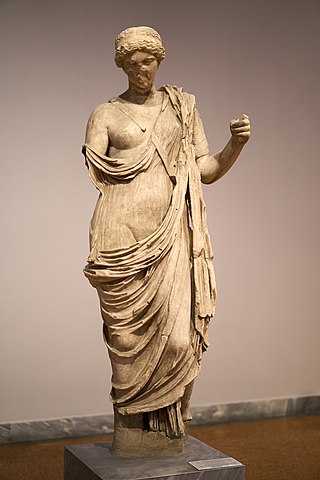
Armed Aphrodite is a first-century AD Roman marble sculpture depicting Aphrodite Areia, or the war-like aspect of the Greek goddess Aphrodite, who was more commonly worshipped as a goddess of beauty and love. It is modelled after a lost Greek original of the fourth century BC made by Polykleitos the Younger, and is now kept in the National Archaeological Museum of Athens in Greece with accession number 262.
